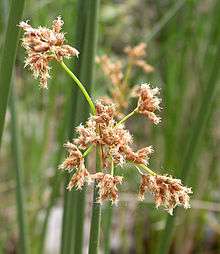Totora (plant)
| Totora | |
|---|---|
 | |
| Totora flower | |
| Scientific classification | |
| Kingdom: | Plantae |
| (unranked): | Angiosperms |
| (unranked): | Monocots |
| (unranked): | Commelinids |
| Order: | Poales |
| Family: | Cyperaceae |
| Genus: | Schoenoplectus |
| Species: | S. californicus |
| Subspecies: | S. c. subsp. tatora |
| Trinomial name | |
| Schoenoplectus californicus subsp. tatora | |
| Synonyms | |
| |
Totora (Schoenoplectus californicus subsp. tatora) is a subspecies of the giant bulrush sedge. It is found in South America - notably on Lake Titicaca, the middle coast of Perú and on Easter Island in the Pacific Ocean. The genus Schoenoplectus is closely related to Scirpus and sometimes included therein.
The people of the mid-coast region of Perú have used totora to build their caballitos de totora, small rowed and straddled fishing vessels, for at least 3,000 years. The Uru people, an indigenous people predating the Inca civilization, live on Lake Titicaca upon floating islands fashioned from this plant. The Uru people also use the totora plant to make boats (balsas) of the bundled dried plant reeds.[1]
The Rapanui people of Easter island used totora reeds – locally known as nga'atu – for thatching and to make pora (swimming aids). These are used for recreation, and were formerly employed by hopu (clan champions) to reach offshore Motu Nui in the tangata manu (bird-man) competition. How the plant arrived on the island is not clear; Thor Heyerdahl argued that it had been brought by prehistoric Peruvians but it is at least as likely to have been brought by birds.[2] Recent work indicates that totora has been growing on Easter Island for at least 30,000 years, which is well before humans arrived on the island.[3][4]
See also
Further reading
- Henri J. Dumont, Christine Cocquyt, Michel Fontugne, Maurice Arnold, Jean-Louis Reyss, Jan Bloemendal, Frank Oldfield, Cees L. M. Steenbergen, Henk J. Korthals & Barbara A. Zeeb (1998). "The end of moai quarrying and its effect on Lake Rano Raraku, Easter Island". Journal of Paleolimnology. 20 (4): 409–422. doi:10.1023/A:1008012720960.
References
- ↑ Encyclopædia Britannica Online: Lake Titicaca. Retrieved 12 July 2007.
- ↑ Heiser, Charles "The Totora ( Scirpus Californicus ) in Ecuador and Peru " Economic Botany Volume 32, Number 3 / July, 1978
- ↑ Fischer, Steven R. Drought, vegetation change, and human history on Rapa Nui Reaktion Books, 2005 ISBN 978-1-86189-245-4 pp. 7-8
- ↑ Easter Island Foundation Frequently Asked Questions